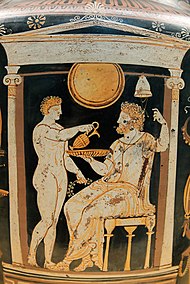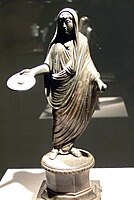Patera

In the material culture of classical antiquity, a patera (Latin pronunciation: [ˈpatɛra]) or phiale (Ancient Greek: φιάλη [pʰi.á.lɛː])[2] is a shallow ceramic or metal libation bowl. It often has a bulbous indentation (omphalos, "belly button") in the center underside to facilitate holding it, in which case it is sometimes called a mesomphalic phiale. It typically has no handles, and no feet.
Although the two terms may be used interchangeably, particularly in the context of Etruscan culture, phiale is more common in reference to Greek forms, and patera in Roman settings.[3] The form should be distinguished from a drinking cup with handles, which is a kylix, and a circular platter with a pair of C-handles is not a patera, though a few paterae have single long straight handles.
Use
[edit]
Libation was a central and vital aspect of ancient Greek religion, and one of the simplest and most common forms of religious practice.[4] It is one of the basic religious acts that define piety in ancient Greece, dating back to the Bronze Age and even prehistoric Greece.[5] Libations were a part of daily life, and the pious might perform them every day in the morning and evening, as well as to begin meals.[6] A libation most often consisted of mixed wine and water, but could also be unmixed wine, honey, oil, water, or milk.[7]
The form of libation called spondē is typically the ritualized pouring of wine from a jug or bowl held in the hand. The most common ritual was to pour the liquid from an oinochoē (wine jug) into a phiale.[8] Libation generally accompanied prayer.[9] The Greeks stood when they prayed, either with their arms uplifted, or in the act of libation with the right arm extended to hold the phiale.[10] After the wine offering was poured from the phiale, the remainder of the contents was drunk by the celebrant.[11]
In Roman art, the libation is shown performed at an altar, mensa (sacrificial meal table), or tripod. It was the simplest form of sacrifice, and could be a sufficient offering by itself.[12] The introductory rite (praefatio) to an animal sacrifice included an incense and wine libation onto a burning altar.[13] Both emperors and divinities are frequently depicted, especially on coins, pouring libations from a patera.[14] Scenes of libation and the patera itself commonly signify the quality of pietas, religious duty or reverence.[15]
-
Etruscan priest with phiale (2nd century BC)
-
Silver patera from Hispania (Roman Spain), 2nd–1st century BC)
-
Patera with Marcus Aurelius (Georgia, 2nd century AD)
-
Roman priest, capite velato (2nd–3rd century AD)
Architecture
[edit]In architecture, oval features on plaster friezes on buildings may be called paterae (plural).[18][19]
See also
[edit]- Parabiago patera, which is actually a platter or plate
- Piyāla - small ceramic easily stackable bowl used by Eurasian nomads people for drinking and Libations
References
[edit]- ^ Simon Janashia Museum of Georgia 122.jpg
- ^ There is no meaningful distinction between the two terms: Nancy Thompson de Grummond and Erika Simon, The Religion of the Etruscans (University of Texas Press, 2006), p. 171; Gocha R. Tsetskhladze, North Pontic Archaeology: Recent Discoveries and Studies (Brill, 2001), p. 239; Rabun Taylor, The Moral Mirror of Roman Art (Cambridge University Press, 2008), p. 104, 269; Rebecca Miller Ammerma, The Sanctuary of Santa Venera at Paestum (University of Michigan Press, 2002), pp. 64, 66.
- ^ Patera is not to be confused with the Greek (Πατέρας) Patéras or Father.
- ^ Louise Bruit Zaidman and Pauline Schmitt Pantel, Religion in the Ancient Greek City, translated by Paul Cartledge (Cambridge University Press, 1992, 2002, originally published 1989 in French), p. 28.
- ^ Walter Burkert, Greek Religion (Harvard University Press, 1985, originally published 1977 in German), pp. 70, 73.
- ^ Hesiod, Works and Days 724–726; Zaidman and Pantel, Religion in the Ancient Greek City, p. 39.
- ^ Zaidman and Pantel, Religion in the Ancient Greek City, p. 40; Burkert, Greek Religion, pp. 72–73.
- ^ Zaidman and Pantel, Religion in the Ancient Greek City, p. 40.
- ^ Burkert, Greek Religion, pp. 70–71.
- ^ William D. Furley, "Prayers and Hymns," in A Companion to Greek Religion (Wiley-Blackwell, 2010), p. 127; Jan N. Bremmer, "Greek Normative Animal Sacrifice," p. 138 in the same volume.
- ^ Zaidman and Pantel, Religion in the Ancient Greek City, p. 40.
- ^ Katja Moede, "Reliefs, Public and Private," in A Companion to Roman Religion (Blackwell, 2007), pp. 165, 168.
- ^ Moede, "Reliefs, Public and Private," pp. 165, 168; Nicole Belayche, "Religious Actors in Daily Life: Practices and Related Beliefs," in A Companion to Roman Religion, p. 280.
- ^ Jonathan Williams, "Religion and Roman Coins," in A Companion to Roman Religion, pp. 153–154.
- ^ John Scheid, "Sacrifices for Gods and Ancestors," in A Companion to Roman Religion, p. 265.
- ^ "Gold phiale (libation bowl)," Metropolitan Museum of Art, accession no. 62.11.1
- ^ British Museum Collection)
- ^ "22, North Street, Ashford, Kent".
- ^ Calder Loth (2010-10-05). "Classical comments: the patera". Institute of Classical Architecture & Art. Archived from the original on 2011-08-10.




![Gold phiale with repoussé bees, acorns, and beechnuts and Greek and Punic inscription (4th–3rd century BC, Met)[16]](http://upload.wikimedia.org/wikipedia/commons/thumb/7/7a/Met%2C_greek%2C_gold_phiale%2C_4-3rd_cventury_BC_01.JPG/198px-Met%2C_greek%2C_gold_phiale%2C_4-3rd_cventury_BC_01.JPG)




![Silver patera from Syria with figures from the founding of Rome (2nd century AD, British Museum[17]](http://upload.wikimedia.org/wikipedia/commons/thumb/b/b7/Ancient_syro-romanian_silver_Patera.jpg/150px-Ancient_syro-romanian_silver_Patera.jpg)